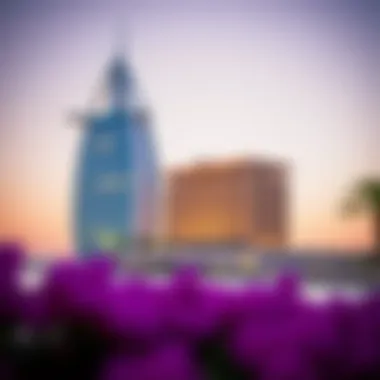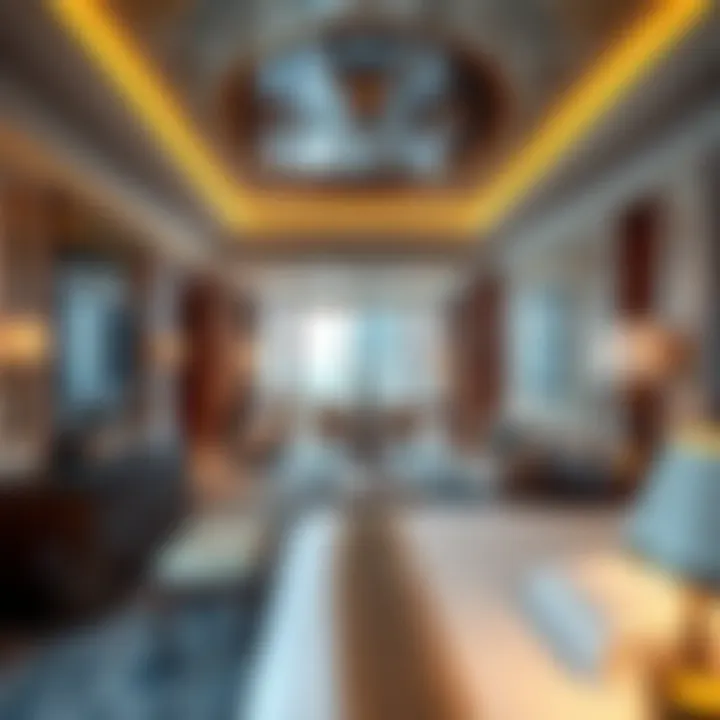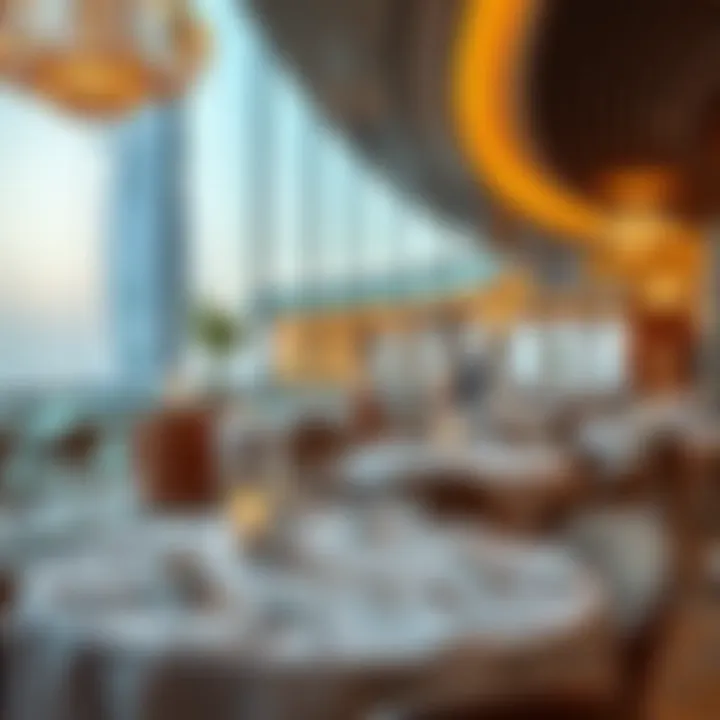Is Burj Al Arab Really a Seven-Star Hotel?


Intro
The Burj Al Arab stands out on the skyline of Dubai, its silhouette resembling a billowing sail. It’s not just a piece of architecture to many; it's a symbol of opulence and extravagance. Often labeled a seven-star hotel, it sparks debate among travelers and experts. What does this term mean? How does it affect the perception of luxury? In this article, we will investigate the roots of the seven-star idea, examine what makes the Burj Al Arab unique, and reflect on how these factors influence luxury hospitality in Dubai as well as the broader international landscape.
Some say that the term "seven-star" is a marketing gimmick conjured up to describe the unmatched luxury that it offers, while others argue it creates unrealistic expectations. The truth lies somewhere in between – and perhaps all around, given that perceptions of luxury vary widely across cultures and markets.
Despite being a five-star hotel in official terms, the Burj Al Arab’s services and amenities could easily make one feel as though they have stepped into a realm that exceeds ordinary definitions of travel and accommodation. With its lavish suites, helicopter transfer from the airport, and stunning views of the Persian Gulf, it is hard to argue that this establishment doesn’t operate on a different level.
Herein, we will delve deeper into market trends related to luxury accommodations, investment insights for potential investors, and ultimately clarify what the term seven-star really encapsulates in the hospitality industry. Expect a thoughtful analysis cemented with real-world details, ensuring a clear understanding of the Burj Al Arab’s unique place in the luxury hotel rankings.
Understanding Hotel Star Ratings
When discussing hotels, one of the first things that comes to mind is the star rating attached to them. These ratings might seem like mere symbols to some, but they carry significant weight in the hospitality industry. Understanding hotel star ratings provides crucial insights into what guests can expect concerning quality, service, and overall experience. With luxury establishments like the Burj Al Arab often compared to the traditional five-star standards, it becomes essential to unpack how these ratings work and why they matter.
The Origin of Star Ratings
The star rating system traces back to the early 20th century, primarily in Europe and the United States. Originally, the system aimed to simplify the selection process for travelers, offering a straightforward way to gauge lodging quality. Over time, various tourism associations and organizations adopted their methods of rating, each with distinct criteria. For example, the American Automobile Association (AAA) developed its diamond system, while others turned to stars. In some places, a simple star rating might denote a basic inn, while in others, it represents a supposedly unparalleled luxury experience.
Criteria for Rating Hotels
So what criteria do hotels usually need to meet for a particular star rating? Various organizations have set distinctive guidelines, but some common elements include:
- Room amenities: Basic furnishings, luxury bedding, and bathroom quality.
- Customer service: Staff-to-guest ratio and service standards.
- Facilities: Availability of pools, gyms, restaurants, and meeting spaces.
- Cleanliness and maintenance: Regular upkeep of rooms and public areas.
Critics argue that these criteria may not fully capture the experience, particularly regarding luxury hotels. For instance, a hotel may boast elegant design yet receive the same star rating as one with less ambiance simply because it meets basic service standards.
Official Standards vs. Perception
The distinction between official star ratings and public perception poses an interesting dilemma. While an official rating provides a baseline understanding of a hotel's offerings, it can also mislead potential guests. The Burj Al Arab famously markets itself as a 'seven-star' hotel, a label not found within traditional classifications. This choice is largely a marketing strategy designed to differentiate the hotel in a saturated luxury market.
"The perception of luxury can be as influential as the services a hotel provides."
Ultimately, the difference between what is officially recognized and guest experiences leads to varying interpretations of hotel quality. What guests perceive as high-end may differ significantly from what regulatory bodies define as such.
Understanding this complex landscape helps prospective visitors navigate their choices in a world where luxury is both a standard and a subjective experience.
Exploring the Burj Al Arab
The Burj Al Arab stands as a symbol of Dubai's unwavering ambition to redefine luxury. This article seeks to dive deeply into the intricacies of this architectural wonder, examining crucial facets that contribute to its reputation. The exploration of the Burj Al Arab isn’t merely about its stunning silhouette against the Dubai skyline; it’s an exploration of what has made this hotel a benchmark in the luxury hospitality industry.
Architectural Marvel
Nestled on its own island, the Burj Al Arab captivates visitors with its unique sail-like silhouette. Designed by the renowned architect Tom Wright, its construction tells a compelling story about the fusion of creativity and engineering prowess. The building's height of 321 meters captures the imagination, but it also serves a practical purpose in Dubai’s hot climate, with dazzling glass and reflective surfaces that help regulate temperature.


The materials used in its construction further enhance its stature as an architectural marvel. From extensive use of reinforced concrete to lavish gold leaf used in interiors, they provide a glimpse into the grandeur that characterizes the hotel. This fusion of imagination and technical skill draws attention from architecture enthusiasts and potential investors alike, marking the Burj Al Arab as a case study in modern design.
"The Burj Al Arab is not just a hotel; it represents an era of aspirations that Dubai has embraced fully."
Innovative Design Features
Innovation flows through the very veins of Burj Al Arab, and it wouldn't be overstating to say that the design is a salient feature contributing to its prestige. One of the most notable design elements is its atrium, standing at over 180 meters, making it one of the highest in the world. Guests are often overwhelmed by the sheer vastness upon entering, creating an immediate sense of awe and luxury.
The hotel’s interiors take opulence to another level with the use of exquisite materials. The lobby, adorned with 24-carat gold leaf and lavish chandeliers, transforms the space into an exhibition of extravagance. It’s not only about aesthetics; functional elements like personalized iPads for room service further showcase the hotel’s dedication to incorporating modern technology into guest experiences, ensuring that everything is designed for convenience.
Luxury Services Offered
When it comes to luxury services, Burj Al Arab truly raises the bar. Providing each guest with an entire suite, the hotel prides itself on unparalleled personal service, including a dedicated butler available at any hour. This ensures that each stay is tailored to meet the unique preferences of visitors, creating unforgettable experiences.
The hotel also offers exceptional amenities, including one of the world’s finest spas. With bespoke treatments designed to rejuvenate both body and mind, the spa is not merely an add-on but rather an integral part of the luxury experience. The signature restaurants, with gourmet chefs and world-class cuisine, provide culinary experiences that tantalize the taste buds, ensuring that dining here is nothing short of extraordinary.
The Seven-Star Legend
The notion of the seven-star hotel has become a significant talking point in the luxury accommodation sector. This concept not only captivates guests and industry insiders but also serves as a marketing tool that can elevate a brand's image. The Burj Al Arab in Dubai is often at the forefront of this conversation, prompting a deeper exploration of what such a classification entails and its implications for the world of hospitality.
Origins of the Seven-Star Concept
The term 'seven-star' was popularized through various sources, many attributing it to a declaration made either by a few self-anointed experts or certain media outlets in the mid-1990s. It is widely accepted that this classification originally emerged from the desire to label hotels that exceed the traditional five-star rating. In essence, it was a way to showcase exceptional luxury and unparalleled service. While organizations like the International Organization for Standardization (ISO) have strict guidelines for hotel star ratings, the seven-star label remains unofficial, operating more in the realm of marketing than concrete measurement.
Many luxury hotels seek to differentiate themselves in a crowded market. Thus, the rise of the seven-star moniker has, in part, become a response to the increasing competition among high-end hotels. It’s a way to signal an extraordinary experience, even if it doesn’t hold any formal recognition.
Media Influence and Public Perception
The role of media in shaping the perception of the seven-star hotel is undeniable. Through attention-grabbing headlines and lavish photo features, outlets can create a narrative that elevates a hotel far beyond its standard ratings. The Burj Al Arab, for instance, has often been described in the media as a symbol of excess and is synonymous with opulence in Dubai. This portrayal aligns with cultural aspirations and the broader image of Dubai as a luxury destination.
The public perception often takes cues from media portrayal, leading people to believe in the existence of a seven-star experience, even if it diverges from established rating criteria. As such, potential guests walk in expecting levels of service and amenities that may not necessarily match a hotel's actual offerings.
"Luxury isn't just about amenities; it's about the experience you carve in every guest's memory."
Comparison with Other Luxury Hotels
If we’re to examine the comparison between the Burj Al Arab and other luxury hotels, the metrics can get quite subjective. For instance, hotels like The Ritz-Carlton in Paris or The Peninsula in Hong Kong often receive five-star ratings but boast equally impressive features that could qualify them for consideration under the elusive seven-star category. However, the Burj Al Arab is uniquely grounded in its themes of extravagance, setting it apart from these competitors.
Some pertinent factors that play a role in this comparison include:
- Architectural Design: The Burj Al Arab's distinctive sail-shaped silhouette is unparalleled.
- Service Standards: Every touchpoint, from check-in to room service, is meticulously crafted.
- Amenities: Private beach access, swimming pools, and top-tier dining complete the lavish offerings.
Implications of the Seven-Star Claim
The idea of the Burj Al Arab being labeled a seven-star hotel carries significant implications for the hospitality industry, particularly in Dubai, where luxury and opulence are a part of the culture. The seven-star claim is not only a marketing gimmick but also an indicator of high expectations and experiences that come with such a label. As the hotel positions itself within this higher echelon of accommodations, it raises questions about standards, perception, and business strategies.


Impact on Marketing Strategies
In the competitive realm of luxury hotels, marketing strategies hinge on creating a compelling narrative. The Burj Al Arab's seven-star claim serves as a powerful tool in its branding. By promoting itself as something beyond the traditional five-star classification, it attracts not just affluent travelers, but also media attention, travel blogs, and influencers. This buzz is invaluable.
For example, when potential guests browse through travel websites, seeing the seven-star label could immediately pique their interest. The hotel has to maintain a specific image, which means investing heavily in unique offerings and services that back up the bold claim. Everything from personalized butler service to one-of-a-kind dining experiences adds to this allure.
Moreover, the marketing strategies employed can also create a sense of exclusivity. By curating events, private access, and amenities that are not readily available elsewhere, Burj Al Arab positions itself as a place where the wealthy can escape the ordinary. This notion fuels demand, which in turn allows for higher rates and profits.
Customer Expectations and Experiences
When a hotel markets itself as seven-star, expectations soar. Guests arrive with the notion that they are entering an ultra-luxurious space where everything should be impeccable. This isn’t just about plush beds or stunning architecture; it extends to every interaction. A guest’s experience can have a ripple effect on the hotel’s reputation. If even a small aspect of their stay feels less than extraordinary, it threatens to tarnish the perception of a seven-star experience.
Consider this: At a hotel of this caliber, customers expect the staff to go above and beyond. From greeting guests by name the moment they enter, to personalizing services based on past visits, every detail matters. Each interaction is a touchstone for the overall experience, and the burden rests on the shoulder of the hotel staff. This creates a culture of rigor within the hotel, with an emphasis on continuous training and raising the bar regularly.
Economic Impacts on the Hospitality Sector
The implications of claiming seven stars extend beyond the walls of the Burj Al Arab and touch the broader hospitality sector. Other hotels, especially those in competitive markets, may feel pressured to re-evaluate their own service offerings and potentially make investments to elevate their status. This creates an environment where luxury standards are continuously pushed higher, influencing pricing strategies and consumer behavior.
Additionally, the seven-star claim can create a perception of Dubai itself as an ultimate luxury destination. As travelers see the Burj Al Arab as a pinnacle of luxury, it can attract more visitors to the region seeking similar experiences, causing economic ripples in other areas like dining, shopping, and entertainment. More visitors mean more revenue, leading to job creation and further investment in hospitality infrastructure.
"The Burj Al Arab elevates not just itself, but the entire city as a beacon of luxury. It encourages other players in the hospitality sector to rethink their game plans or risk fading into the background."
Evaluating the Burj Al Arab in Context
Evaluating the Burj Al Arab holds significant relevance in understanding its status in the ultra-competitive world of luxury hospitality. The building isn't just a hotel; it's a symbol of opulence that many aspire to experience. This section dissects the Burj Al Arab not merely as a business entity but as an icon that shapes perceptions of luxury in the hospitality industry.
In context, assessing the Burj Al Arab allows travelers, investors, and industry stakeholders to discern what makes a hotel exemplary. With its bold architectural signature against the Dubai skyline, the hotel serves as a lens through which we can examine trends, preferences, and competition in high-end accommodations. This understanding also brings to light how expectations find form in experiences—how luxury translates in different cultures, and how a hotel can set itself apart amid glitzy competitors.
A Benchmark for Luxury Hotels
The Burj Al Arab is frequently held up as a benchmark for luxury hotels, not by some arbitrary rating but through its unique offerings. When the term 'luxury hotel' is uttered, it’s hard not to think of this establishment. With its sail-shaped silhouette, it not only catches the eye but also stirs the imagination.
What sets this hotel apart are several factors:
- Bespoke services: Each guest is treated to personalized attention that goes above and beyond the expected. Whether it’s a private chauffeur in a Rolls-Royce or a dedicated butler at your service, the experience screams exclusivity.
- Lavish interior design: The extravagance of the interiors, featuring 24-carat gold leaf decorations, crystal chandeliers, and sumptuous fabrics, raises the bar for aesthetic appeal among its peers.
- Unique amenities: The Burj offers several unique features like underwater dining at Al Mahara and sky-high drinks at the Skyview Bar, creating memorable experiences that guests talk about long after their stay.
These elements contribute to why the Burj Al Arab sets the gold standard in luxury accommodations. Its distinctive offerings provide both a tangible and experiential model that other hotels may strive to emulate.
Case Studies of Notable Competitors
To better understand the Burj Al Arab's exceptional position, it’s essential to consider relevant case studies from notable competitors in the luxury hotel market. Several establishments worldwide aim for similar prestige, but few can boast the same level of recognition.
- The Ritz Paris: Known for its luxury, this hotel features a rich history with elite clientele, yet its traditional elegance contrasts with the modern architectural flair of the Burj Al Arab.
- The Mandarin Oriental, Tokyo: Situated in a bustling metropolis, it offers world-class services and design but leans towards contemporary aesthetics rather than the iconic luxe that characterizes the Burj.
- The Four Seasons Resort Bora Bora: Although more secluded and exotic, this resort matches the Burj in terms of exceptional service and amenities for privacy-seeking guests.


By contrasting these hotels with the Burj Al Arab, one can see how the Dubai landmark excels in conveying luxury not just through its facilities but in shaping a distinctive brand identity that resonates with affluent travelers.
The Role of Customer Reviews
Customer reviews play a powerful role in evaluating any hotel, and the Burj Al Arab is no exception. While some guests arrive with sky-high expectations infused by marketing, others come with a fresh perspective and no preconceptions. Here’s what customer feedback generally reveals:
- Exceeding Expectations: Many guests leave reviews highlighting how their experiences surpassed what was promised in marketing materials. This positive imbalance is crucial for a luxury hotel.
- Critiques and Concerns: Interestingly, not all reviews are glowing. Some guests point out areas for improvement, such as price versus value or comparing Burj Al Arab to boutique hotels offering high-end customization.
- Influence on Future Guests: Reviews significantly affect potential customers' decisions. Travelers often cite reviews when choosing accommodations, putting pressure on hotels to maintain high standards.
Ultimately, the Burj Al Arab can gain valuable insights from customer reviews, both in celebrating what they do right and addressing areas for improvement. By focusing on guest feedback, they ensure that their luxury offering remains relevant and appealing.
In summary, evaluating the Burj Al Arab within the context of the hospitality landscape reveals its pivotal role as a benchmark, while also highlighting significant competitors and the influence of customer opinions. This thorough analysis helps cultivate an appreciation for how the hotel industry continues to evolve, blending tradition with modern demands.
"In the realm of luxury, perception often trumps reality, but the Burj Al Arab has made considerable strides to ensure their reality matches, or even exceeds, that perception."
Prospects for the Future
Understanding the future of luxury hospitality isn't just a matter of trends; it's about predicting how establishments like the Burj Al Arab will navigate an ever-evolving market. With the spotlight firmly on experiences rather than just the roof over one's head, the Burj must adapt to changes in traveler expectations, innovative technologies, and competitive pressures that shape what luxury means today. This section discusses several vital elements that will significantly impact the hotel's future standing.
Evolving Standards in Luxury Hospitality
Luxury today isn’t solely defined by opulent decor and top-ranked service; it encompasses a broader narrative, addressing personal preferences and distinct experiences. As travelers become more discerning, they expect high standards to adapt dynamically. This means hotels must now consider sustainability, local culture, and wellness elements as part of their identity. The Burj Al Arab, with its iconic visual presence, is poised at a critical junction; its next steps will likely intertwine traditional luxury with contemporary values.
- Sustainability: With growing awareness of environmental issues, travelers are increasingly favoring hotels that exemplify sustainable practices. The Burj Al Arab may need to implement energy-efficient systems, reduce waste, and endorse eco-friendly products to resonate with the eco-conscious traveler.
- Cultural Experiences: As the world flattens due to globalization, guests might prefer authentic connections with local traditions and cultures. Agendas that include cultural immersions beyond the resort's boundary could elevate the Burj's appeal, fulfilling a desire for genuine experiences.
- Enhanced Personalization: With AI and data analytics becoming commonplace, guests expect tailored experiences that meet their unique preferences. A system that anticipates the desires of travelers, whether it's preferred room temperature or dining choices, could enhance guest satisfaction, setting the hotel apart.
The Burj Al Arab's Adaptation in a Competitive Market
In a lavish market like Dubai, the competition is fierce. While the Burj al Arab may be perceived as a pioneer of luxury, maintaining a prominent position requires not only recognition but also a commitment to continuous improvement. Rival hotels are not just matching aesthetics; they are innovating with cutting-edge technologies that enhance customer experiences.
- Investment in Technology: From smart room features to integrated apps that allow extensive control over guests’ stays, tech isn't an optional upgrade anymore. The Burj must consider investing in hotel management systems that improve efficiency without sacrificing that impeccable human touch guests expect.
- Reimagining Offerings: Unique culinary experiences, wellness programs, and curated excursions can provide a competitive edge. Collaborations with ultra-luxury brands or exclusive partnerships for bespoke experiences could be crucial.
- Flexible Pricing Models: An attractive pricing strategy catering to various demographics can widen the guest base. Seasonal packages that entice first-time visitors could also prove beneficial, giving the Burj a foothold in a price-sensitive market.
Emerging Trends in Luxe Accommodations
The future of luxury hotels is not a static concept. Instead, it is a rapidly changing landscape influenced by global economic conditions, technological advancements, and shifts in consumer behavior. Several trends are emerging that could reshape the definitions of luxury accommodations:
- Health and Wellness Focus: The stressors of modern life have turned wellness into a multi-billion dollar industry. Hotels investing in amenities like spa treatments, fitness centers, and healthy dining are more likely to attract health-conscious travelers.
- Digital Nomadism: The rise of remote work opportunities increases demand for long-term stays where guests can flexibly weave work and leisure. Hotels that foster environments conducive to productivity—like high-speed Wi-Fi and ergonomic workspaces—are likely to thrive.
- Social Responsibility: With consumers increasingly focused on social values, hotels that support local charities or engage in community development effectively resonate with guests. Aligning corporate identity with social responsibility is not just a choice; it’s a necessity for creating loyalty in an informed consumer base.
"Luxury is no longer about what you own; it’s about experiences and emotions you create with your choices."
By keeping these perspectives in mind, the Burj Al Arab can ensure it not only remains relevant but continues to lead in the ever-competitive field of luxury hospitality.
Epilogue
In wrapping up our exploration of the Burj Al Arab’s famed yet questionable seven-star status, it becomes clear that the appeal of this hotel transcends mere star ratings. The perception of luxury is often as subjective as it is defined, inviting varied interpretations by travelers and industry experts alike. The Burj Al Arab has successfully constructed a narrative around opulence that piques the interest of investors and luxury seekers, warranting deeper inspection into what constitutes true luxury.
Summarizing Key Insights
The journey through this article highlights several critical points:
- The Myth and Reality of Star Ratings: Star ratings are significantly influenced by criteria that vary across countries and organizations. While some hotels tout a higher classification based on their unique offerings, these ratings rarely reflect the true essence of luxury.
- Architectural Grandeur and Unique Services: The Burj Al Arab stands as a testament to architectural innovation, boasting features that set it apart from the competition. From its sail-shaped silhouette to extravagant services like 24-carat gold leaf decoration, the hotel encapsulates a new standard in hospitality.
- Impact of Marketing on Perception: The narrative constructed around the Burj Al Arab's status intricately ties into its marketing strategies, which appeal heavily to an audience that values exclusivity and prestige. This branding strategy aids in forming perceptions that may not align with any formal rating.
- Customer Experience vs. Market Expectations: As customers walk through the gilded doors of the Burj Al Arab, their expectations are often overwhelming. Understanding this spectrum of experiences is crucial for the hospitality sector at large, particularly in a fiercely competitive market like Dubai.
- Future Trajectories in Luxury Hospitality: As the luxury sector continues adapting, changes in customer preferences can influence what travelers expect from upscale accommodations. The Burj Al Arab must continue innovating and evolving to sustain its lofty status.
Ultimately, the Burj Al Arab embodies a blend of luxury, art, and ingenuity that is not easily categorized by simple star ratings. The seven-star legend continues to spark debate and fuel conversation, proving that true extravagance extends far beyond a numerical value.



